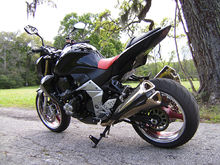 Kawasaki introduced the Z1 (900) motorcycle in 1972 as the first of the Kawasaki Z series. Four years later they introduced the Kz900.
The original Z1 was the first series of Japanese motorcycles with the
combination of four cylinders, dual overhead cams and 903 cc
(55.1 cu in).
Kawasaki introduced the Z1 (900) motorcycle in 1972 as the first of the Kawasaki Z series. Four years later they introduced the Kz900.
The original Z1 was the first series of Japanese motorcycles with the
combination of four cylinders, dual overhead cams and 903 cc
(55.1 cu in).
Reg Pridmore's 1978 Superbike Championship Vetter Kawasaki
From 1979, a 'Mk 2' (mark two) version was added with black engine, general restyling including body and paintwork and a shaft-drive version was available, designated Z1000ST. The models continued until superseded by the fuel-injection Z1000H and GPZ1100 of the early 1980s
In 2003 Kawasaki introduced a completely revamped 30 year anniversary edition of the Z1000. It used a modified engine from the Kawasaki ZX-9R, and was bored out by 2.2 mm resulting in bigger displacement, more low-RPM torque, and only a slight power loss of 4 bhp from the original ZX9.[citation needed] In 2004, Kawasaki released the Z1000's smaller brother, the Z750. In 2007, Kawasaki released a new Z1000. The Z-series since the 1970s until today are also known as the "Z", "Zed", and "Z1k".
In October 2009, Kawasaki unveiled the 2010 Z1000. It had a new aluminum frame, digital instrument panel, bodywork, and engine. Bore and stroke are 77 x 56 mm, 1 mm more than the ZX-10R’s 76 x 55 mm displacing 1,043 cc. That is up from the previous model's 953 cc. Compression ratio is 11.8:1, and fuel injection is handled by a bank of 38 mm Keihin throttle bodies.[1]
2003–2006 Models
 Stylistically,
the 2003 Z1000 was a departure from other naked sportbikes of the time.
The Z1000 used the same tail section that was being used on the 2003
ZX6R 636 cc sport bike. Kawasaki hired the same industrial designer
credited with designing the Mazda Miata to create an aggressive bikini fairing to match the 636s tail section.[citation needed]
Stylistically,
the 2003 Z1000 was a departure from other naked sportbikes of the time.
The Z1000 used the same tail section that was being used on the 2003
ZX6R 636 cc sport bike. Kawasaki hired the same industrial designer
credited with designing the Mazda Miata to create an aggressive bikini fairing to match the 636s tail section.[citation needed]The Z1000 uses a backbone frame that supports the engine as a stressed member. Engine mounts can be removed to ease access for maintenance.
Compression damping is done on one fork leg, rebound damping on the other. This technology is from dirt bikes, and is rare on street motorcycles. The Nissin brakes have four piston calipers.
2007–2009 Models
2007 Kawasaki Z1000
2010–2013 Models
Kawasaki Z1000 right-side 2011 Tokyo Motor Show
2014 Z1000 at the Seattle International Motorcycle Show
 The Z1000 was redesigned for 2010. Along with the customary styling
update came a slightly larger capacity engine. The motorcycle was
officially marketed as the "Z1000 ABS" as ABS came fitted as standard.[2]
The Z1000 was redesigned for 2010. Along with the customary styling
update came a slightly larger capacity engine. The motorcycle was
officially marketed as the "Z1000 ABS" as ABS came fitted as standard.[2]In 2013 Kawasaki broke with the 3 year update cycle and choose to release a "special edition", alongside the standard edition, to mark the 40th anniversary of the Z brand.[3] The differences between the models were purely aesthetic.

Aucun commentaire:
Enregistrer un commentaire